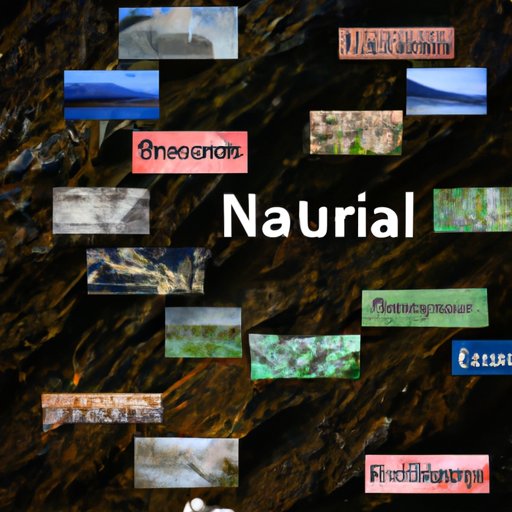Introduction
Natural resources are materials and components that can be found within the environment. They occur naturally and can be used for economic, social, and environmental benefit. Natural resources can be divided into renewable and nonrenewable resources. Renewable resources can be replenished over time, while nonrenewable resources are finite and cannot be replaced once they are used up.
Examining the Economic and Environmental Impact of Different Natural Resources
Fossil fuels, such as coal, oil, and natural gas, are nonrenewable resources that have been used to produce energy for centuries. While these resources are still widely used today, their use has caused massive environmental damage due to air and water pollution. Additionally, the burning of fossil fuels adds to the growing problem of climate change.
Renewable energy sources, such as solar, wind, hydropower, and geothermal energy, are becoming increasingly important sources of energy. These sources of energy are clean and efficient, and can help reduce our reliance on fossil fuels. In addition, renewable energy sources can be used to generate electricity and power homes, businesses, and industries.
Minerals and metals, such as copper and iron ore, are used in a variety of industries and products. These resources are essential for the production of cars, electronics, and other manufactured goods. However, mining activities can result in environmental damage, including air and water pollution.
Water and air resources are essential for life on Earth. Water is used for drinking, agriculture, and industry, while air is necessary for the survival of plants and animals. Unfortunately, both water and air resources are being polluted by human activities, resulting in serious health and environmental consequences.
Forests and wildlife provide a variety of benefits to humans, including timber, food, medicine, and recreational activities. Forests are also essential for maintaining the balance of the Earth’s climate and providing habitats for a variety of species. The destruction of forests and wildlife due to human activities has had devastating effects on global ecosystems.

Exploring the Role of Natural Resources in Human History
Ancient civilizations relied heavily on natural resources for their survival. For example, the Ancient Egyptians used the Nile River for transportation and irrigation, while the Incas used gold and silver for trade and currency. Natural resources were also essential for the development of early cities and societies.
The Industrial Revolution saw an unprecedented increase in the demand for natural resources. Coal and iron ore were mined in large quantities to fuel the growing manufacturing industry, while forests were cleared for the production of paper and other goods. This period also saw a dramatic rise in air and water pollution.
Today, natural resources are still essential for our modern lifestyle. Fossil fuels are used to generate electricity and power our homes, while minerals and metals are used to produce cars, electronics, and other manufactured goods. Water is used for drinking, agriculture, and industry, while forests provide timber, food, and recreational activities.

Analyzing the Benefits and Challenges of Different Natural Resources
There are many advantages to using natural resources. They are relatively inexpensive, abundant, and easy to access. In addition, they can be used to generate electricity and power homes, businesses, and industries. However, there are also some drawbacks to using natural resources.
The use of natural resources can cause environmental damage, such as air and water pollution. In addition, the over-exploitation of natural resources can lead to the depletion of finite resources, such as fossil fuels and minerals. Finally, the destruction of forests and wildlife can have devastating effects on global ecosystems.
Investigating the Potential for Renewable Natural Resources
Renewable energy sources, such as solar, wind, hydropower, and geothermal energy, are becoming increasingly important sources of energy. These sources of energy are clean and efficient, and can help reduce our reliance on fossil fuels. In addition, they can be used to generate electricity and power homes, businesses, and industries.
Solar power is one of the most promising renewable energy sources. Solar panels absorb sunlight and convert it into electricity, which can then be used to power homes and businesses. Wind power is another promising source of renewable energy. Wind turbines capture the kinetic energy of the wind and convert it into electricity.
Hydropower is another form of renewable energy. Hydropower plants use the force of falling or flowing water to generate electricity. Geothermal energy is generated from heat stored beneath the Earth’s surface, and can be used to generate electricity as well as to heat and cool buildings.

Understanding the Impact of Depletion of Natural Resources on Society
The depletion of natural resources can have serious consequences for society. Climate change is one of the most significant effects of the depletion of natural resources. The burning of fossil fuels releases carbon dioxide into the atmosphere, which contributes to global warming and climate change.
Poverty and inequality can also be caused by the depletion of natural resources. When natural resources are depleted, people living in poverty may not have access to basic necessities, such as food and clean water. In addition, the loss of biodiversity is a major concern, as it can lead to the extinction of species and the disruption of ecosystems.
Conclusion
Natural resources play an essential role in our lives. They can be used to generate electricity, power homes and businesses, and produce a variety of goods. However, the depletion of natural resources can have serious consequences for society, including climate change, poverty, and loss of biodiversity. Renewable energy sources, such as solar, wind, hydropower, and geothermal energy, offer the potential for clean and efficient energy production. As we move forward, it is essential that we take steps to protect and conserve our natural resources.


